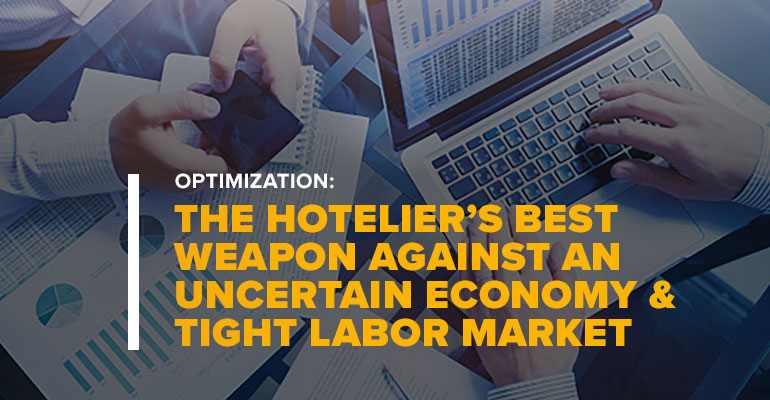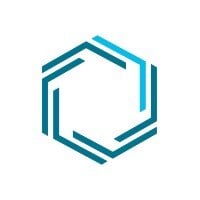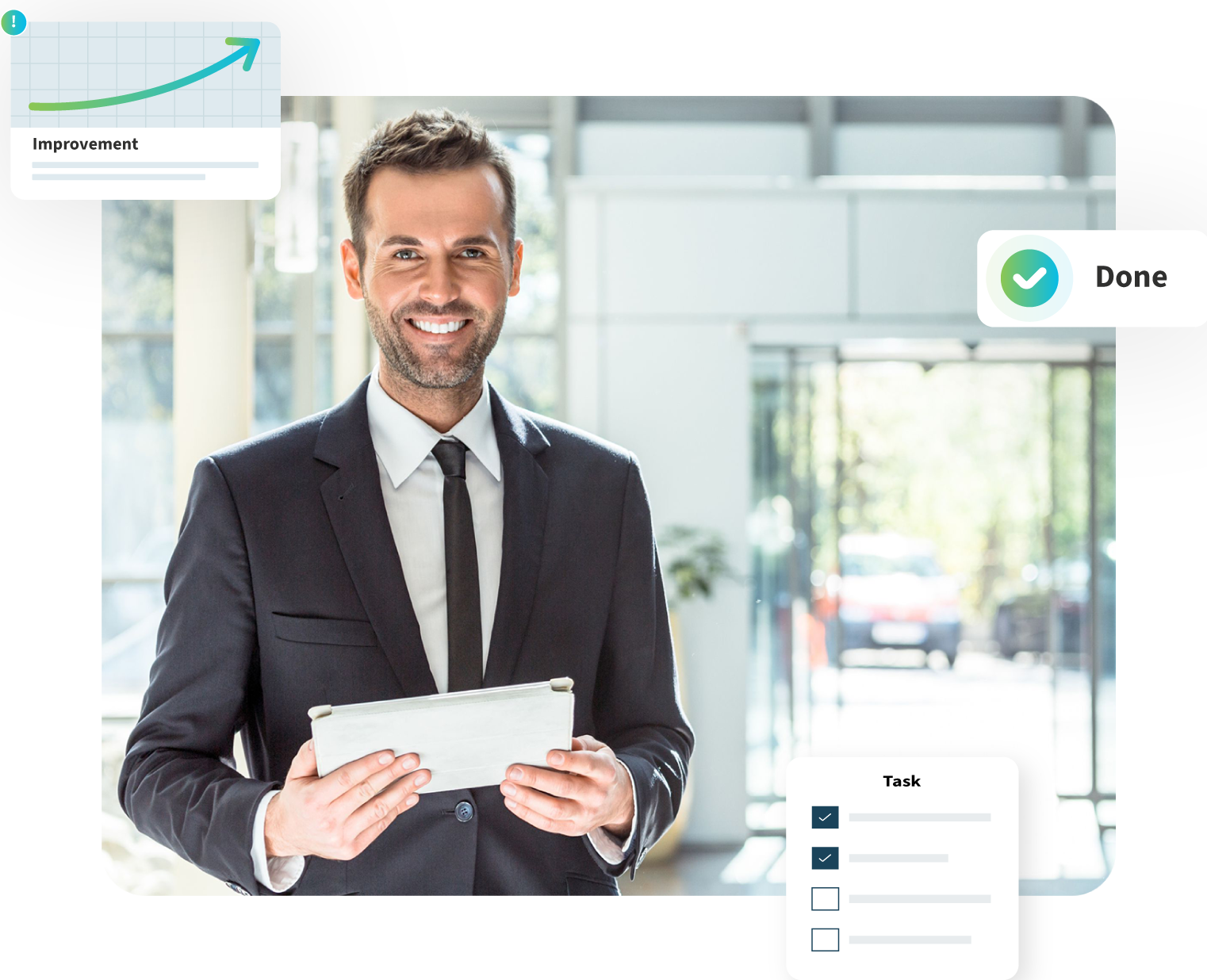March 11, 2019 - By Mark Heymann, Chairman & CEO, UniFocus - Published in Hotel Executive – The first quarter is already painting an interesting picture for 2019, with promising forecasts for growth in the hospitality industry tempered by the possibility of an economic recession by the end of the year. Here are just a few of the projections and points of view offered by experts that have contributed to this complex outlook:
- Hotel occupancy is anticipated to continue to grow for the 10th consecutive year, achieving a fifth straight record level for the industry.
- Restaurant sales closed strong in 2018, driving optimism that the momentum built will carry well into 2019.
- Hospitality continues to face a tight labor market, with projected unemployment remaining mostly unchanged.
- Wage pressure increases as more than 20 states raised the minimum wage, with the US hotel industry outpacing the nation in wage growth.
- Factors such as climate change or "weaponization of travel" may affect hospitality in ways that are difficult to predict.
- More than half of CFOs in the U.S. believe recession is likely by end of 2019 and Deloitte forecasts substantial slowing in economic growth in 2020.
These mixed projections mean the hospitality industry must accommodate short-term growth while planning for the possibility of a longer-term slowdown. It also must be flexible enough to respond to unexpected events, such as storms and other acts of nature or sudden downturns in tourism. And then there is the continued challenge of attracting and retaining talent in a low-unemployment environment. Put it all together, and the clear priority for hotel operators in 2019 is workforce optimization.
What Does it Really Mean to Optimize?
In simplest terms, optimization means consistently delivering against customer expectations to drive revenue, while managing costs to maximize profitability. Almost anyone can pursue a least-cost environment through cost cutting, but that approach is rarely optimal and usually results in compromises that hurt the business and brand. To truly optimize your operations, you must know your customer. And, you must focus your time, team, and budget on the specific things that keep them coming back.
That intent to return and recommend is the dependent variable in optimized performance, because achieving that level of customer satisfaction hinges on your workforce. All aspects of workforce performance-skills, attitude, availability, and timing-must be aligned if you are to meet the most important expectations of your customer. Because of this, employee engagement becomes a critical part of workforce optimization: In addition to knowing your customer, you have to understand your service giver's frame of mind and attitude when in the workplace.
Deeper Knowledge Enables More Creative Solutions
With a deeper understanding of the specific factors driving both guest satisfaction and employee engagement, you'll gain creative options to optimize operations. For example, if one of your primary markets is the boomer generation and you are maintaining a traditional restaurant schedule, you have likely seen a progressive decline in food and beverage revenue-even if your guests are satisfied with the quality of the food and beverage product. Earlier timing of availability for full-service dinner meals has become a priority for many of these diners.
A solution would be to extend restaurant hours, offering workers a shorter mid-shift schedule option and reducing staffing during later hours based on actual demand flow. This presents a very desirable schedule option both for students, who typically have classes in the mornings and study in the evenings, as well as for late Generation X/early baby boomer staff who would like to work more lucrative dinner shifts but want to end their days earlier.
To do so would mean rethinking minimum shifts and possibly offering a higher hourly rate for shorter mid-shifts. However, if the revenue opportunity is significant enough, such a move could prove to be more profitable, despite the higher average hourly labor costs.
Four Steps to Optimization
Optimization not only requires greater precision in forecasting and planning, but also a willingness to rethink tightly held assumptions about hotel operations. Its payoff, however, is a level of agility that enables operators to adjust and maintain performance as the market changes.
Here are four steps to get started:
1. Integrate Your Data
Moving into an optimization strategy requires the elimination of siloed data. Traditionally, marketing has focused on guest satisfaction, human resources on employee engagement, and operations on productivity. Optimizing workforce performance means addressing the entire guest, employee and cost experience, making it necessary to look at all of these aspects of your business from a cause-and-effect standpoint.
The idea is to streamline-not to increase the burden of big data already being experienced by regional and unit managers. Operators must invest in the right technologies that bring these data together and make the complex tasks required for optimization-such as precise forecasting, planning and scheduling-simple for any manager. A key is to create a data format than enables variances to be easily analyzed, reacted to and improved upon.
2. Ask Your Customers
The fundamental starting point for optimization is to know your customer. If you pay attention, your guests will tell you where to focus to satisfy what is most important to them-–and what matters less. Too often, hotel and restaurant operators treat guest satisfaction/engagement surveys as a box to check rather than a strategic optimization tool. An effective guest survey should provide the information hoteliers need to clearly answer two key questions:
- What are your guests' expectations?
- What factors most influence their intent to return and recommend?
Avoid the temptation to assign all guests a single "persona." This will be a challenge, since most survey tools do exactly that. As an operator, you already know that within a single guest category there are segments with varying needs. The expectations of a business traveler with a single night stay are different from those of someone who stays multiple nights. Understanding those differences is key to satisfying the needs of both guests.
Ensure your managers are equipped with technologies that simplify administrative workloads. This will enable them to manage from the floor so they can develop meaningful relationships with guests, providing context to the information you learn from guest surveys.
Once you know the factors that matter most to your customers, use them to inform necessary capital investments and integrate them into your workforce performance management processes and technology in order to optimize standards, forecasts and planning.
3. Engage Your Employees
There is no question that engaged employees work more efficiently, improving bottom-line results. They also bring a level of commitment and passion to their work that results in higher-quality service delivery and greater guest satisfaction, which ultimately drives top-line revenue.
UniFocus found that for one of our hotel customers, a 10% increase in employee engagement scores translates on average to an increase of $50,000 in annual room revenue for a 100-room property. These results validated our decision to integrate employee engagement into our Workforce Performance Optimization suite. Data across a wide variety of our hospitality clients has confirmed that those who measure employee engagement and act on those learnings consistently perform better.
Today's workforce, led by a millennial majority, has a different set of expectations than previous generations. They want greater control in managing their schedules and a better work/life balance. This priority has led to a rise in predictive scheduling laws, enacted in response to workers who felt that employers were not respectful enough of their time or responsive to their requests.
As more millennials enter management roles, they are already shifting the culture in organizations. Begin working with them from this perspective today. Ensure they have the ability to manage their schedules the way they manage the rest of their lives-from their smartphones. This will have the added benefit of improving communication between staff and managers. It will also provide an ideal platform to implement pulse surveys to measure engagement and get ongoing feedback from your team throughout the year.
4. Upgrade Your Technology
Optimizing and streamlining your operations and organization puts greater demand on technology. While a good manager can at times optimize a schedule, it is simply faster, more consistent and easier to use smart algorithms and artificial intelligence to generate precise forecasts and automate scheduling. Managers only have to fine-tune schedules, gaining back hours of valuable time they can redirect to training and engaging team members and serving customers.
The right investment in workforce performance optimization technology will bring guest, employee, and operational performance data together into a solution that reduces complexity of tasks and overall workload for managers. And, it will give you the insights and capabilities you need to fully optimize your operations. The right solution should:
- Provide clarity on customer priorities to drive focus for optimization
- Simplify and improve short-term forecasting based on historical and comprehensive environments data
- Automate scheduling to map to actual customer demand based on a holistic view of your data
- Provide business intelligence to inform continuous refinement of standards
- Improve your top and bottom line
Putting it All Together
Optimization is a balancing act that requires continuous learning and adjusting. It means responding to changes in customer preferences and employee attitudes and needs, and rethinking metrics and standards to efficiently meet the evolving demands of the market. Advanced technology is the critical mechanism that enables an organization to meet those challenges. Most organizations have various components of this integrated solution today. But putting all of those measures in place so that they "speak" to each other is no small task. By laying the groundwork now, however, your organization will be well positioned not only to weather the uncertainties of 2019 but to respond to any market conditions that lie ahead.






